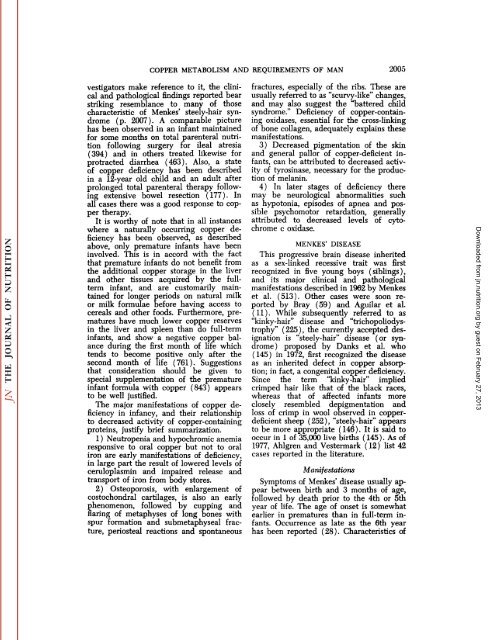conspectus of researchon copper metabolism and requirements
conspectus of researchon copper metabolism and requirements
conspectus of researchon copper metabolism and requirements
Create successful ePaper yourself
Turn your PDF publications into a flip-book with our unique Google optimized e-Paper software.
COPPER METABOLISM AND REQUIREMENTS OF MAN 2005<br />
vestigators make reference to it, the clini<br />
cal <strong>and</strong> pathological findings reported bear<br />
striking resemblance to many <strong>of</strong> those<br />
characteristic <strong>of</strong> Menkes' steely-hair syn<br />
drome (p. 2007). A comparable picture<br />
has been observed in an infant maintained<br />
for some months on total parenteral nutri<br />
tion following surgery for ileal atresia<br />
(394) <strong>and</strong> in others treated likewise for<br />
protracted diarrhea (463). Also, a state<br />
<strong>of</strong> <strong>copper</strong> deficiency has been described<br />
in a 12-year old child <strong>and</strong> an adult after<br />
prolonged total parenteral therapy follow<br />
ing extensive bowel resection ( 177). In<br />
all cases there was a good response to cop<br />
per therapy.<br />
It is worthy <strong>of</strong> note that in all instances<br />
where a naturally occurring <strong>copper</strong> de<br />
ficiency has been observed, as described<br />
above, only premature infants have been<br />
involved. This is in accord with the fact<br />
that premature infants do not benefit from<br />
the additional <strong>copper</strong> storage in the liver<br />
<strong>and</strong> other tissues acquired by the fullterm<br />
infant, <strong>and</strong> are customarily main<br />
tained for longer periods on natural milk<br />
or milk formulae before having access to<br />
cereals <strong>and</strong> other foods. Furthermore, pre<br />
matures have much lower <strong>copper</strong> reserves<br />
in the liver <strong>and</strong> spleen than do full-term<br />
infants, <strong>and</strong> show a negative <strong>copper</strong> bal<br />
ance during the first month <strong>of</strong> life which<br />
tends to become positive only after the<br />
second month <strong>of</strong> life (761). Suggestions<br />
that consideration should be given to<br />
special supplementation <strong>of</strong> the premature<br />
infant formula with <strong>copper</strong> (843) appears<br />
to be well justified.<br />
The major manifestations <strong>of</strong> <strong>copper</strong> de<br />
ficiency in infancy, <strong>and</strong> their relationship<br />
to decreased activity <strong>of</strong> <strong>copper</strong>-containing<br />
proteins, justify brief summarization.<br />
1) Neutropenia <strong>and</strong> hypochromic anemia<br />
responsive to oral <strong>copper</strong> but not to oral<br />
iron are early manifestations <strong>of</strong> deficiency,<br />
in large part the result <strong>of</strong> lowered levels <strong>of</strong><br />
ceruloplasmin <strong>and</strong> impaired release <strong>and</strong><br />
transport <strong>of</strong> iron from body stores.<br />
2) Osteoporosis, with enlargement <strong>of</strong><br />
costochondral cartilages, is also an early<br />
phenomenon, followed by cupping <strong>and</strong><br />
flaring <strong>of</strong> metaphyses <strong>of</strong> long bones with<br />
spur formation <strong>and</strong> submetaphyseal frac<br />
ture, periosteal reactions <strong>and</strong> spontaneous<br />
fractures, especially <strong>of</strong> the ribs. These are<br />
usually referred to as "scurvy-like" changes,<br />
<strong>and</strong> may also suggest the "battered child<br />
syndrome." Deficiency <strong>of</strong> <strong>copper</strong>-contain<br />
ing oxidases, essential for the cross-linking<br />
<strong>of</strong> bone collagen, adequately explains these<br />
manifestations.<br />
3) Decreased pigmentation <strong>of</strong> the skin<br />
<strong>and</strong> general pallor <strong>of</strong> <strong>copper</strong>-deficient in<br />
fants, can be attributed to decreased activ<br />
ity <strong>of</strong> tyrosinase, necessary for the produc<br />
tion <strong>of</strong> melanin.<br />
4) In later stages <strong>of</strong> deficiency there<br />
may be neurological abnormalities such<br />
as hypotonia, episodes <strong>of</strong> apnea <strong>and</strong> pos<br />
sible psychomotor retardation, generally<br />
attributed to decreased levels <strong>of</strong> cytochrome<br />
c oxidase.<br />
MENKES' DISEASE<br />
This progressive brain disease inherited<br />
as a sex-linked recessive trait was first<br />
recognized in five young boys (siblings),<br />
<strong>and</strong> its major clinical <strong>and</strong> pathological<br />
manifestations described in 1962 by Menkes<br />
et al. (513). Other cases were soon re<br />
ported by Bray (59) <strong>and</strong> Aguilar et al.<br />
(11). While subsequently referred to as<br />
"kinky-hair" disease <strong>and</strong> "trichopoliodystrophy"<br />
(225), the currently accepted des<br />
ignation is "steely-hair" disease (or syn<br />
drome) proposed by Danks et al. who<br />
( 145) in 1972, first recognized the disease<br />
as an inherited defect in <strong>copper</strong> absorp<br />
tion; in fact, a congenital <strong>copper</strong> deficiency.<br />
Since the term "kinky-hair" implied<br />
crimped hair like that <strong>of</strong> the black races,<br />
whereas that <strong>of</strong> affected infants more<br />
closely resembled depigmentation <strong>and</strong><br />
loss <strong>of</strong> crimp in wool observed in <strong>copper</strong>deficient<br />
sheep (252), "steely-hair" appears<br />
to be more appropriate ( 146). It is said to<br />
occur in 1 <strong>of</strong> 35,000 live births (145). As <strong>of</strong><br />
1977, Ahlgren <strong>and</strong> Vestermark (12) list 42<br />
cases reported in the literature.<br />
Manifestations<br />
Symptoms <strong>of</strong> Menkes' disease usually ap<br />
pear between birth <strong>and</strong> 3 months <strong>of</strong> age,<br />
followed by death prior to the 4th or 5th<br />
year <strong>of</strong> life. The age <strong>of</strong> onset is somewhat<br />
earlier in prematures than in full-term in<br />
fants. Occurrence as late as the 6th year<br />
has been reported (28). Characteristics <strong>of</strong><br />
Downloaded from<br />
jn.nutrition.org<br />
by guest on February 27, 2013
















